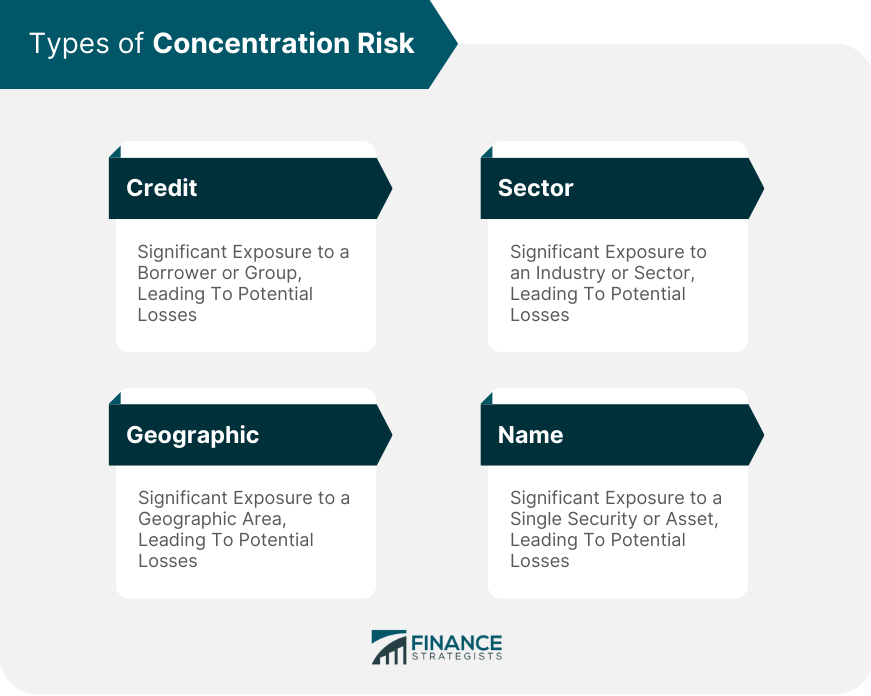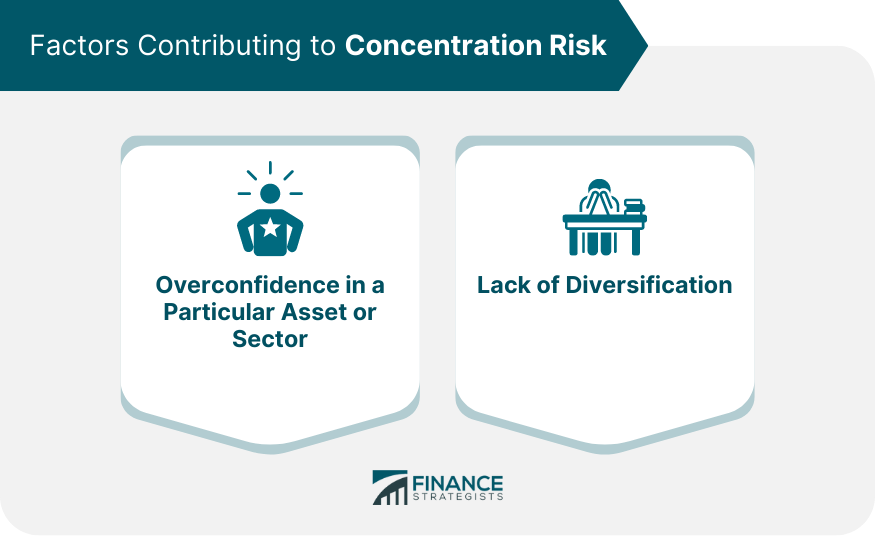Concentration risk can be defined as the potential for financial loss due to an overexposure to a single counterparty, sector, or geographic region. It is a crucial factor for investors, financial institutions, and regulators to consider in order to maintain a healthy and stable financial system. The presence of concentration risk increases the vulnerability of a portfolio to market fluctuations and economic downturns. It is essential for investors to understand the different types of concentration risk and their potential impact on their investments. There are four main types of concentration risk: credit, sector, geographic, and name concentration risk. Each type represents a different aspect of potential overexposure in a portfolio or financial institution. Credit concentration risk arises when a financial institution or investor has a significant exposure to a single borrower or a group of borrowers. This risk can lead to substantial losses if the borrower defaults on their obligations, affecting the financial stability of the institution or investor. Institutions and investors should monitor their credit exposure and ensure it is adequately diversified to mitigate the impact of any potential defaults. A well-diversified portfolio reduces the likelihood of substantial losses from a single borrower's default. Sector concentration risk occurs when a portfolio or institution has a significant exposure to a particular industry or sector. This risk can result in losses if the sector experiences a downturn or faces challenges that negatively impact its performance. Diversifying across different sectors can help mitigate sector concentration risk. By doing so, investors can reduce the impact of a downturn in one sector by having exposure to others that may perform better during the same period. Geographic concentration risk is the potential for loss that arises when a portfolio or financial institution has a significant exposure to a particular geographic area. This risk can result from economic or political instability in the area or from external events such as natural disasters. To mitigate geographic concentration risk, diversification across different regions is recommended. Investors and financial institutions should assess their exposure to different geographic areas regularly and adjust their portfolios accordingly. Name concentration risk, on the other hand, arises when a portfolio or financial institution has significant exposure to a single security or asset. This risk can lead to substantial losses if the value of the security or asset declines, affecting the overall portfolio or financial stability of the institution. Adequate diversification of assets is essential to mitigate name concentration risk. Investors and financial institutions should monitor their exposure to individual securities or assets and ensure that they are adequately diversified to reduce the impact of any potential losses. Understanding the factors that contribute to concentration risk is essential for investors and financial institutions to manage and mitigate its potential impact. Overconfidence in a particular asset or sector can lead to concentration risk. Investors or financial institutions may believe that a specific asset or sector is a safe investment, leading to overexposure and increased vulnerability to market fluctuations. It is important for investors to constantly reassess their investments and not become overly reliant on a single asset or sector. This includes regularly reviewing their portfolio's performance and staying informed about market trends and developments. A lack of diversification can contribute to concentration risk, as it increases the potential for losses if an overexposed asset or sector underperforms. Investors and financial institutions should ensure that their portfolios are well-diversified across different assets, sectors, and geographic regions. Diversification helps to spread risk across a variety of investments, reducing the impact of any single underperforming asset or sector. Regular portfolio reviews and rebalancing can help maintain a well-diversified portfolio and manage concentration risk effectively. There are several methods for measuring concentration risk, including concentration ratios and portfolio analytics. These tools can help investors and financial institutions assess their exposure to concentration risk and make informed decisions about risk management. Concentration ratios, such as the Herfindahl-Hirschman Index (HHI) and the Gini coefficient, are used to measure concentration risk. These ratios provide a numerical representation of the level of concentration within a portfolio or financial institution, helping to identify potential areas of overexposure. The HHI and Gini coefficient are widely used in the financial industry to assess concentration risk. Understanding these ratios and their implications can help investors and financial institutions make more informed decisions about their exposure to concentration risk and develop strategies to mitigate potential losses. Portfolio analytics involve assessing the risk metrics and stress testing a portfolio to identify areas of potential concentration risk. By analyzing the risk metrics of a portfolio, investors can gain insights into their exposure to various types of concentration risk and make necessary adjustments. Stress testing involves simulating various market scenarios and economic conditions to determine how a portfolio would perform under different circumstances. This can help identify potential areas of concentration risk and provide valuable information for developing risk management strategies. Effective management of concentration risk is crucial for maintaining a stable and healthy financial system. This involves identifying and assessing risk, implementing diversification strategies, and establishing risk limits and monitoring. The first step in managing concentration risk is identifying and assessing the potential areas of overexposure in a portfolio or financial institution. This can be achieved through regular portfolio reviews, market analysis, and the use of concentration ratios and portfolio analytics. Once the areas of concentration risk have been identified, investors and financial institutions can develop strategies to mitigate the potential impact of overexposure, including diversifying their investments and setting risk limits. Diversification strategies are essential for managing concentration risk. These strategies include asset allocation, sector and geographic diversification, and rebalancing portfolios. Asset allocation involves distributing investments across different asset classes, such as stocks, bonds, and real estate, to reduce the impact of concentration risk. Sector and geographic diversification involve spreading investments across various industries and regions to minimize the potential impact of downturns in specific sectors or regions. Rebalancing portfolios involves adjusting the weights of different assets, sectors, and regions within a portfolio to maintain a desired level of diversification. Regular rebalancing can help ensure that a portfolio remains well-diversified and better equipped to manage concentration risk. Setting risk limits and regular monitoring are important aspects of managing concentration risk. Risk limits involve establishing thresholds for acceptable levels of concentration risk within a portfolio or financial institution. Regular monitoring and reporting are crucial for ensuring that concentration risk remains within acceptable levels. This includes tracking portfolio performance, reviewing concentration ratios, and staying informed about market developments that may impact the risk profile of a portfolio or financial institution. The impact of concentration risk can be better understood through case studies, such as the subprime mortgage crisis, the Enron collapse, and the European debt crisis. The subprime mortgage crisis, which began in 2007, was a result of concentration risk in the financial sector. Banks and other financial institutions had a significant exposure to subprime mortgages, which led to substantial losses when the housing market collapsed. The crisis highlighted the importance of managing concentration risk and the need for greater diversification in the financial sector. It also demonstrated the potential consequences of overexposure to a single asset class or sector. The Enron collapse in 2001 is another example of the impact of concentration risk. Enron, a major energy company, collapsed due to fraudulent accounting practices and an overreliance on a single business model. The Enron collapse serves as a reminder of the importance of diversification and the need for transparency in financial reporting. It also underscores the potential consequences of concentration risk for investors and financial institutions. Concentration risk is a significant concern for investors and financial institutions alike. The potential for loss due to having a substantial portion of assets or liabilities in a single source can have serious consequences, including financial losses, operational disruptions, and reputational damage. To manage concentration risk, diversifying assets or liabilities across different sources, monitoring and analyzing risk exposures regularly, and implementing risk mitigation strategies are essential. Going forward, ongoing efforts to improve risk management practices and regulatory frameworks will be crucial for mitigating the impact of concentration risk on the financial system.What Is Concentration Risk?
Types of Concentration Risk
Credit Concentration Risk
Sector Concentration Risk
Geographic Concentration Risk
Name Concentration Risk

Factors Contributing to Concentration Risk
Overconfidence in a Particular Asset or Sector
Lack of Diversification

Measuring Concentration Risk
Concentration Ratios
Portfolio Analytics
Managing Concentration Risk
Risk Identification and Assessment
Diversification Strategies
Risk Limits and Monitoring
Case Studies of Concentration Risk
The Subprime Mortgage Crisis
The Enron Collapse
Conclusion
Concentration Risk FAQs
Concentration risk refers to the potential for loss that arises from having a significant portion of assets or liabilities in a single source.
Concentration risk can be measured using various metrics such as Herfindahl-Hirschman Index (HHI), sectoral concentration, and geographic concentration.
The two main types of concentration risk are asset concentration risk and liability concentration risk.
Concentration risk can lead to significant financial losses, operational disruptions, and reputational damage.
Concentration risk can be managed by diversifying assets or liabilities across different sources, monitoring and analyzing risk exposures regularly, and implementing risk mitigation strategies.
True Tamplin is a published author, public speaker, CEO of UpDigital, and founder of Finance Strategists.
True is a Certified Educator in Personal Finance (CEPF®), author of The Handy Financial Ratios Guide, a member of the Society for Advancing Business Editing and Writing, contributes to his financial education site, Finance Strategists, and has spoken to various financial communities such as the CFA Institute, as well as university students like his Alma mater, Biola University, where he received a bachelor of science in business and data analytics.
To learn more about True, visit his personal website or view his author profiles on Amazon, Nasdaq and Forbes.











